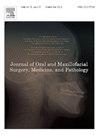对骨髓母细胞瘤中干细胞相关的 Sox2 和 Klf4 进行免疫组化评估
IF 0.4
Q4 DENTISTRY, ORAL SURGERY & MEDICINE
Journal of Oral and Maxillofacial Surgery Medicine and Pathology
Pub Date : 2024-08-22
DOI:10.1016/j.ajoms.2024.08.014
引用次数: 0
摘要
目的我们旨在研究性决定区Y相关高迁移率组盒2(Sox2)和类克鲁珀因子4(Klf4)这两种干细胞相关分子在牙源性组织中的潜在作用。结果在牙槽骨瘤病例中,Sox2 和 Klf4 的免疫反应主要出现在牙层。在 54 例牙釉质母细胞瘤中,有 48 例检测到 Sox2 和 Klf4 的表达,并且主要定位于邻近基底膜的肿瘤细胞。Sox2在牙泡中的表达量远高于在成釉细胞瘤中的表达量。粒细胞性母细胞瘤的 Sox2 和 Klf4 水平低于棘细胞性母细胞瘤。结论 Sox2 和 Klf4 在牙泡和成釉细胞瘤中的不同表达模式表明,这些转录因子可能参与了牙源性组织的调控。由于这些转录因子与牙源性上皮细胞的增殖和分化有关,它们可能有助于肿瘤的发生或疾病的预后。本文章由计算机程序翻译,如有差异,请以英文原文为准。
Immunohistochemical assessment of stem cell-related Sox2 and Klf4 in ameloblastomas
Purpose
We aimed to investigate the potential roles of sex-determining region Y-related high mobility group-box 2 (Sox2) and Krüppel-like factor 4 (Klf4), two stem cell-related molecules, in odontogenic tissues.
Methods
Immunohistochemical reactivity to Sox2 and Klf4 was examined in 10 dental follicle and 54 ameloblastoma specimens. The association between these molecules and clinical variables was analyzed in ameloblastoma cases.
Results
Dental follicles showed immunoreactivity to Sox2 and Klf4 predominantly in the dental lamina. In ameloblastomas, Sox2 and Klf4 expression was detected in 48 of the 54 cases, and was predominantly localized in neoplastic cells adjacent to the basement membrane. Sox2 showed substantially higher expression in dental follicles than in ameloblastomas. Granular cell ameloblastomas presented lower levels of Sox2 and Klf4 than acanthomatous ameloblastomas. Moreover, immunoreactivity of ameloblastomas to Sox2 and Klf4 was slightly higher in recurrent cases than in non-recurrent cases.
Conclusions
The differential expression patterns of Sox2 and Klf4 in dental follicles and ameloblastomas indicate that these transcription factors may be involved in the regulation of odontogenic tissues. As these transcription factors are associated with cell proliferation and differentiation in the odontogenic epithelium, they may contribute to tumorigenesis or disease prognosis.
求助全文
通过发布文献求助,成功后即可免费获取论文全文。
去求助
来源期刊

Journal of Oral and Maxillofacial Surgery Medicine and Pathology
DENTISTRY, ORAL SURGERY & MEDICINE-
CiteScore
0.80
自引率
0.00%
发文量
129
审稿时长
83 days
 求助内容:
求助内容: 应助结果提醒方式:
应助结果提醒方式:


